#elder futhark rune study Facebook
Explore tagged Tumblr posts
Text
Rune Art: Silverhand Design
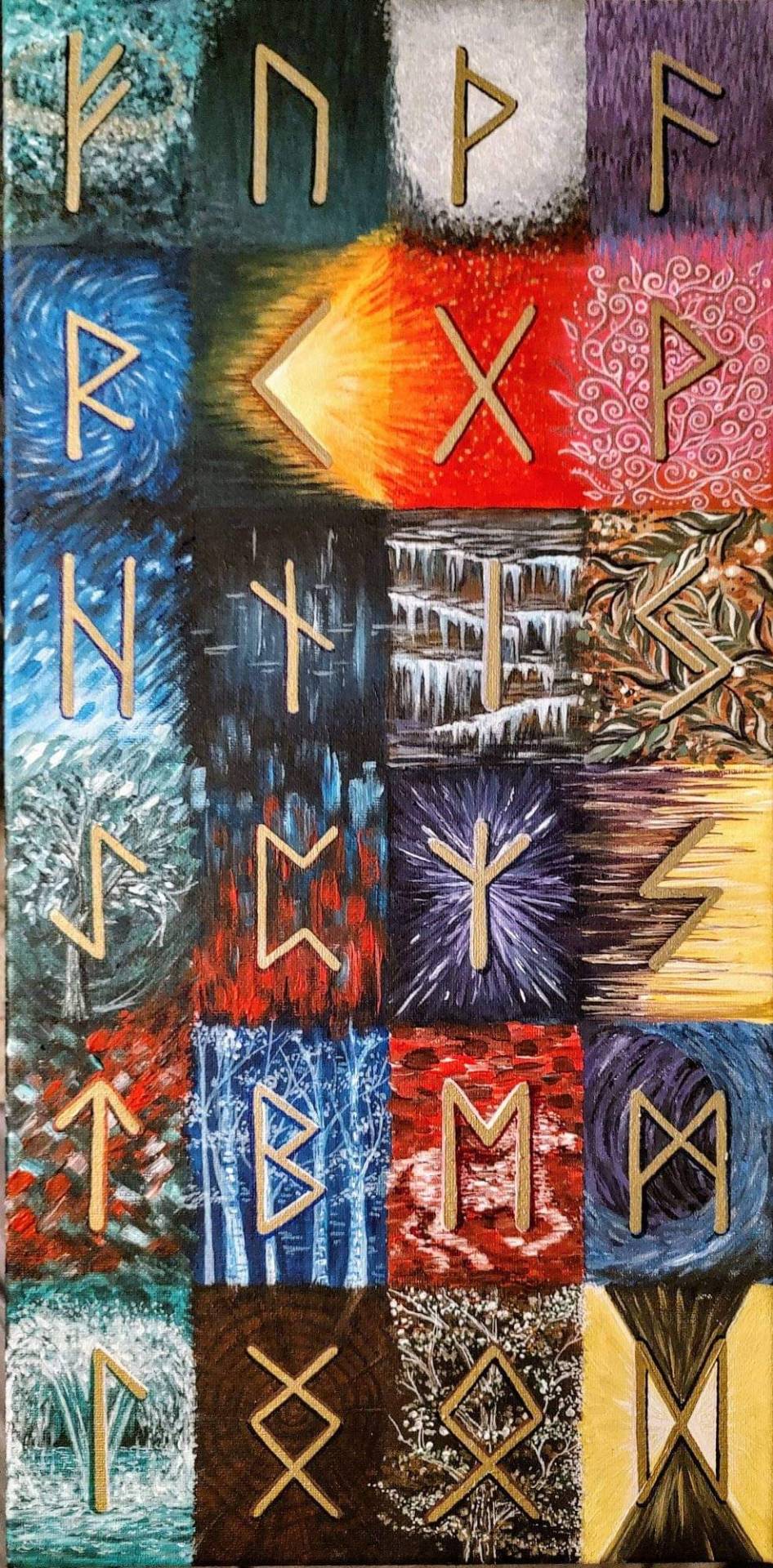
Rune art that was created by Silverhand Design while studying the Elder Futhark. Each rune was represented by an abstract painting composed of the colors and feeling attributed to them.
Shared on Elder Futhark Rune Study (Facebook private group.)
#Silverhand Design#elder futhark rune study#elder futhark rune study Facebook#Rune Art#rune art#rune design#Rune Design#abstract rune art#abstract art#rune#runes#Rune#Runes#Futhark#futhark#elder futhark#Elder Futhark#elder futhark runes#norse runes#futhark runes#rune designs
43 notes
·
View notes
Photo





Proto-Germanic
The Proto-Germanic language is the ancestor of all Germanic languages, including those who have gone extinct by now and those that still exist, including the one I am currently using to write this post. The Proto-Germanic language is a descendant of the Proto-Indo European language and was spoken in north-western Europe, countries like Denmark, southern Sweden, Southern Norway, northern Germany and the northern Netherlands.
The language is entirely reconstructed which means that there is very little physical archeological evidence of this language. The language was reconstructed with the help of Grimm's law, developed by Jacob Grimm (the same Grimm who published those fairy tales). Grimm's law is a set of statements describing the consonant changes in the Germanic languages all the way back to the Proto-Indo-European language. With this statement it is possible to pick a modern day Germanic word and derive this word back to an older version from a previous language.
Here are a few examples: Modern day word: English - foot, Frisian - foet, German - Fuß, Swedish - fod Proto-Germanic root: fot Proto-Indo-European: consonant f changes back into p, Pods.
Modern day word: English - what, Dutch/Frisian - wat, German - was, Danis - hvad, Norwegian - hva Proto-Germanic root: hwat Proto-Indo-European: consonant hw changes back into k, kwod.
Modern day word: English - goose, Dutch/German - gans, Frisian - goes, Danish/Norwegian/Swedish - gås Proto-Germanic root: gans Proto-Indo European: ghens
Note that it is very important that the word you want to apply grimm's law to, is actually Germanic in origin. You can know this by checking if the word is similar in other modern day Germanic languages. It is per example more difficult to use English for Proto-Germanic studies than German, Dutch, Frisian or Danish because the English language contains a lot of loan words from the French language. Of course there are many more rules than just these consonant changes in order to reconstruct the Proto-Germanic language. I am however quite bad at explaining grammar rules in English because English is not my native language.
The Proto-Germanic language was most likely spoken by the Germanic people around 500BC but developed into three distinct branches around 200-150BC. These three branches are: West-Germanic, East-Germanic and North Germanic.
West-Germanic: The West-Germanic language developed into several different languages which were and are spoken in modern day the Netherlands, Belgium, Great Britain and parts of western Germany. The West-Germanic language itself divided into three branches as well: North sea Germanic, which includes languages like old Frisian, old English and old Saxon which in turn evolved into the modern day languages of Frisian, English and low German/plat Duits.
Then you have the Weser-Rhine Germanic branch which is the ancestor of the low Franconian, Rhine Franconian and the old high German languages. These languages developed into the modern day languages of Dutch, Afrikaans and German. The last West-Germanic branch is the Elbe Germanic which is the ancestor of the upper German, Central German dialects and the extinct Langobardic language.
East-Germanic: Sadly all of the East-Germanic languages are extinct right now but they consisted of languages like: Gothic, Vandalic, Burgundian. The last Gothic language, Crimean Gothic, went extinct in the 18th century in Crimea. Even though these languages are now extinct, several texts have been found in these languages which makes reconstructing them a bit easier. Still it is quite a shame that we have lost these languages.
North-Germanic: The North-Germanic language evolved into the Scandinavian languages in two branches, West-Scandinavian and East-Scandinavian. West-Scandinavian includes languages like: West old Norse, Norse, Icelandic, Faroese, Norn. The East-Scandinavian branch includes languages like: East old Norse, Swedish, Danish, Gutnish and all of its dialects.
The Proto-Germanic language is also the language of the original runes, the elder futhark. Each name of the runes is in fact a Proto-Germanic name. You can observe this well if you use another Germanic language like German, Dutch or Frisian and compare them with the elder futhark names. (It doesn't work that well in English thanks to all its loan words). Per example the first rune Fehu is still similar to the modern day Dutch - Vee, German - Vieh and Frisian - Fee while the modern day English word cattle is a loan word from the old French word chatel.
At the beginning of this post I mentioned that there is very little physical evidence for the Proto-Germanic language, that is because of course the ancient Germanic people didn't write anything down. Yet it is still a miracle that there are tiny traces left like the Vimose inscriptions from around 200AD, the word harja spelled out in the elder futhark on a comb per example. The Negau inscription on a helmet and the transcription of several words used by Tacitus in his work Germania.
I hope this post has given you a bit more information on what language the ancient Germanic people spoke and how it developed into the languages we still speak until this very day. I suggest you go and try to study the language that interests you the most. I know most asatrus have their heart set on old Norse but remember that old Norse is just a branch of the Germanic languages, it is by no means the heart of the Germanic religion nor is it the language of the earliest runes. I myself find it interesting to study and write in the Proto-Germanic language.
Here are pictures of: The Germanic languages tree (Yes this is not the complete tree because that image is too big for a facebook post.) Vimose inscription on a comb, 160AD found in Denmark. The Negau inscription (note that the helmet dates back to 450BC and was created by the Celts, the inscription however was added later around 200-150BC, it reads harikastiteiip. The names of the elder futhark. A Proto-Germanic poem that I have written myself.
90 notes
·
View notes
Link
I am a diviner and a hard polytheist, a writer of fiction and a general troublemaker. I have an oath with Odin, work loosely with Loki and Thor, and have had dabblings with the sidhe. The main tools of my trade are elder futhark runes, tarot and bibliomancy, and I'm learning astrology and pendulum reading at the moment. However, in 2019 I made a deal with Odin to study divination on a larger scale and I'm focusing on learning as much as I can and forging some ways of my own.
This is where Patreon comes in. An important part of my practice is the ability to share my skills as a diviner and a storyteller with the world, but an important part of being able to make my passion my livelihood means being able to pay the bills. With Patreon, I am able to offer readings at a reduced price that makes them accessible to more people, as well as sharing the notes on divination that I sell on my web store for free at higher tiers. Patreon subscribers also get access to exclusive channels on my Discord server.
Click below the cut for details of what tiers are available.
Blog | Store | Twitter | Facebook | Tumblr | Instagram | Ko-fi | Discord

Patreons donating $3 a month get access to weekly pick a card readings on Patreon, highlighting the tarot decks that I own, as well as advanced notice of when my readings will be free on tumblr and reviews of my divination tools.
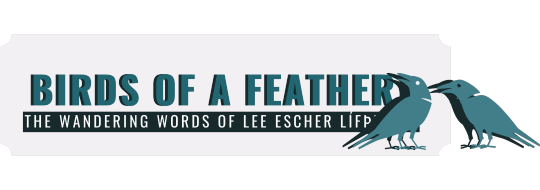
Patreons donating $9 a month get everything at the previous tier, as well as access to the free weekly readings channel on my discord, and the "Page a Diviner" channel where you can ask for advice on your divination problems.

Patreons donating $20 a month get everything at the previous tiers, as well as free access to the "Divination Keywords Series" available for sale at my web store, and a monthly intensive one-on-one reading (tarot or runes) where I will go over your question and discuss it with you in detail in a live 1-hour chat.
#lee talks#patreon#divination#tarot#runes#futhark#hellenic runes#oracle cards#free readings#readings#patreon benefits#signal boost
6 notes
·
View notes
Link
You cannot translate anything into runes, full stop. Runes are not a language, they are signs devised to represent the sounds of a language, the same way as letters. You also cannot represent anything in runes correctly. No kind of correctness standard may be applied to the Viking Age runic inscriptions, at least in the current state of research.
(I do not take credit for this guide. It was made by the author of Vikingrune.com)
Lewis Carroll while travelling in Russia liked the word защищающихся (meaning ‘those who protect themselves’ as he noted in his diary) and wrote it down in English: zаshtshееshtshауоushtshееkhsуа. The Russian word has 12 letters, the English one as many as 30. Did Carroll write it correctly? There are two ways to check it: a) finding a universally accepted chart of correspondences between Russian and English letters; b) showing the word to some Russian guy and asking him if he can understand it.
Neither of two is feasible for Old Norse. The Viking Age did not produce any accepted chart of such correspondences (even between the sounds of the Old Norse language and runes, which would be spelling, let alone the modern English sounds or letters and Viking runes, which would be transliteration). Everyone carved runes as he or she deemed truly good and right. The only criterion of correctness was the fact that people could actually understand what the inscription said. This method no longer works, since all native Proto Norse and Old Norse speakers are long dead.
Now imagine some Russian guy who shows up and says: “Hi, my ancestors were Germans who emigrated to the US and then to Russia. To honor them I want to tattoo the word защищающихся on my back / to engrave onto my bike / to carve it on my bat. Which letters should I take, those used in the US, clean and simple, or those used in Germany, with umlauts, bells and whistles? Keep in mind that I have to write it correctly (because I want to tattoo it on my back / to engrave onto my bike / to carve it on my bat). And don’t forget to quote your sources (I already got a couple of answers in other places, they all differ, so I want to check)”.
What would you say? The obvious answer is: study either US English or German and write something in English or German with alphabets devised for those languages. Leave that zаshtshееshtshауоushtshееkhsуа thing alone. It’s ugly.
But studying languages is painful. That’s why the guy from Russia says: “Translate the word защищающихся into English for me. Keep in mind that I have to write it correctly. And don’t forget to quote your sources.” Now you try to explain that the form защищающихся is the genitive case, and no such thing as cases exists in English. So there are some options more or less corresponding to the original like “of those who defend themselves” and “about those who defend themselves” but there is no single correct version (why on earth would he need the genitive?). The guy begins to think that you fool him.
That’s what I feel when I get on my Facebook page or here in the comments questions like this: “I am of Norwegian / Swedish / Danish descent. I want to translate the word victory / glory / ivory into runes. Which set of runes should I use? Keep in mind that I have to write it correctly, because…” you know.
Even though finding Old Norse words for victory / glory / ivory is not that difficult, my general advice is to keep them in standard Old Norse orthography in Roman letters. The point is that contrary to the common misunderstanding, Younger Futhark runes were not meant for the standard Old Norse, as we know it in Eddas and sagas. Viking Age runic inscriptions reveal an older form of the language, in many respects significantly differing from the later texts. A large amount of runic material is understood only tentatively. The truth is we cannot establish a complete grammar and vocabulary for the language of the Viking Age Younger Futhark runic inscriptions allowing to translate coherent texts from other languages into it. As for the Elder Futhark, it isn’t suited for Old Norse inscriptions altogether, as I wrote in my short Guide to Writing in Runes.
What might be the practical advice for those who still wish authentic runic texts as tattoos / carvings / engravings? The best option is to search through the existing Viking Age runic material, which is already interpreted with a satisfying degree of certainty, and use it as is.
In the posts to follow I’ll try to collect such fragments of runic texts, which may be of interest for use by us modern people.
See also:
How to Write a Name in Runes for a Tattoo How to Write an Authentic Runic Inscription Should I Write in Runes Phonetically?
3 notes
·
View notes
Text
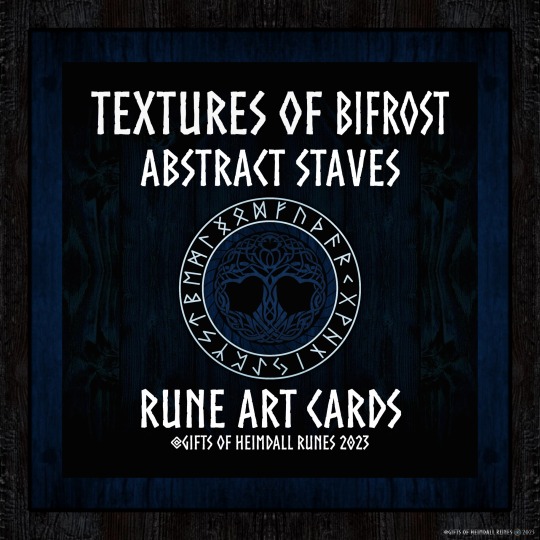

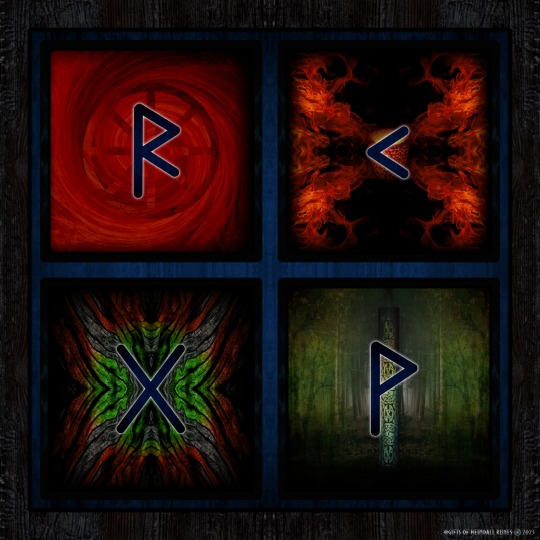
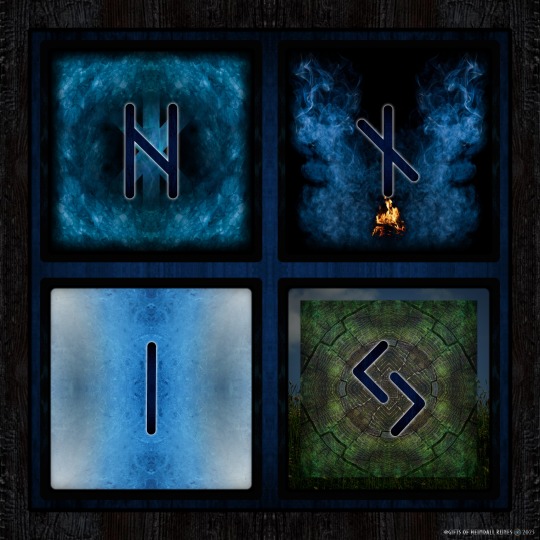

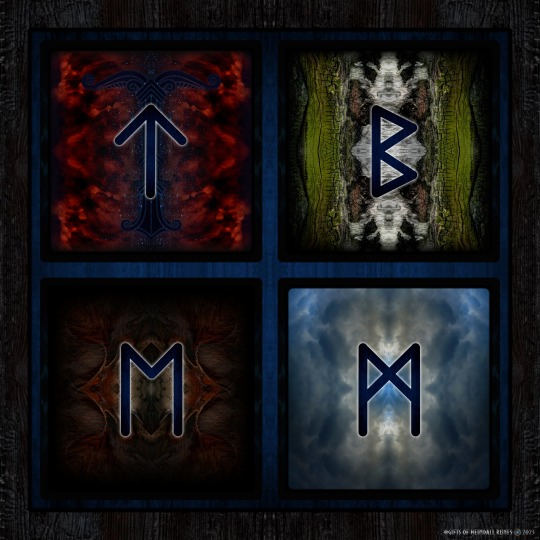

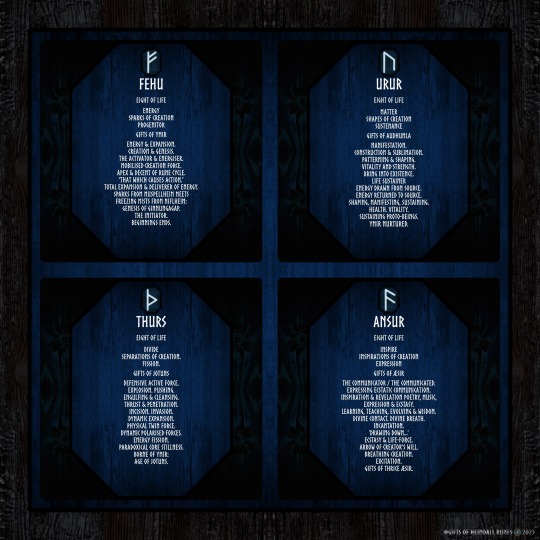
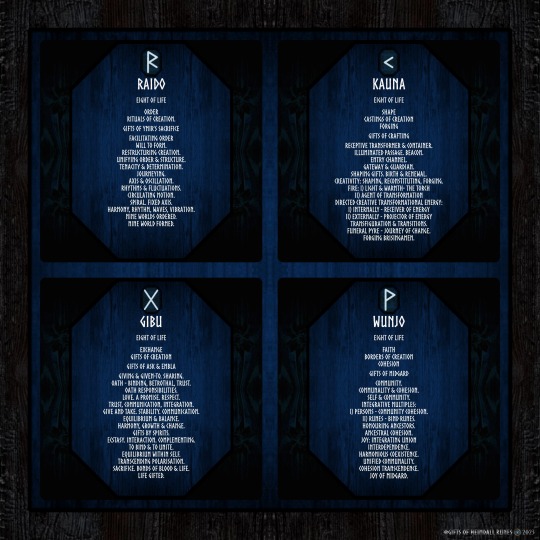
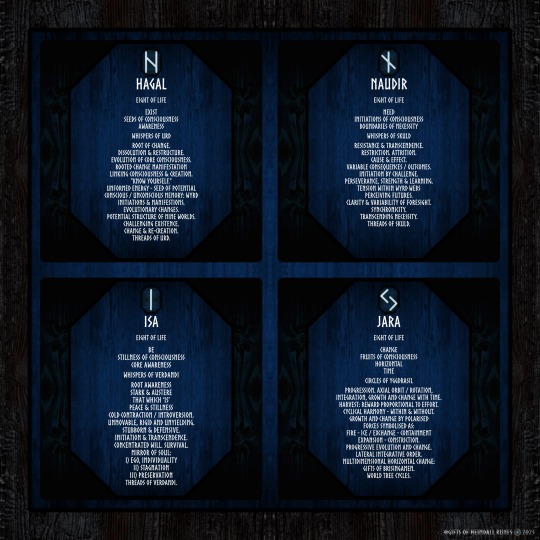

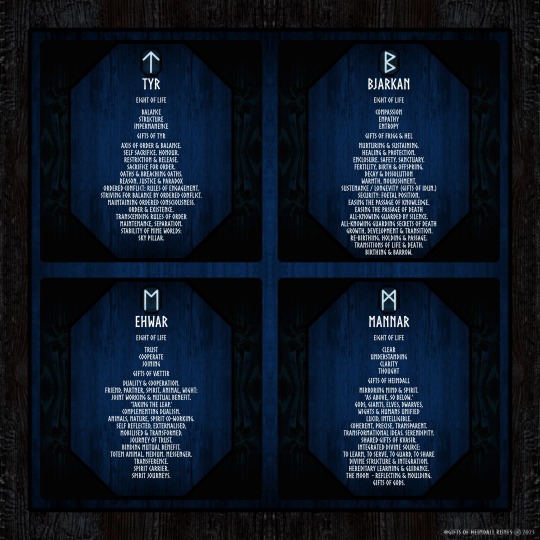
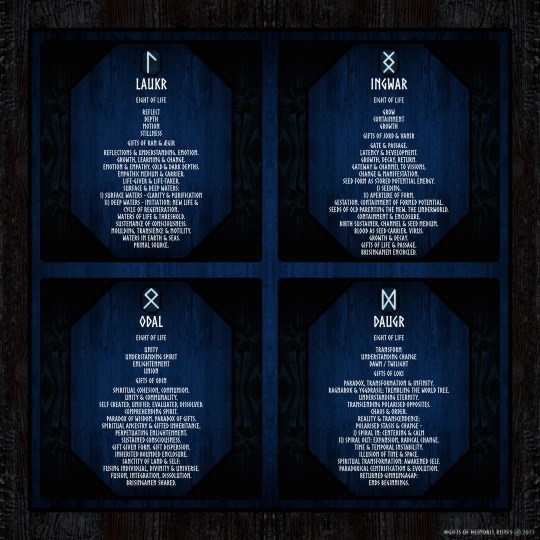
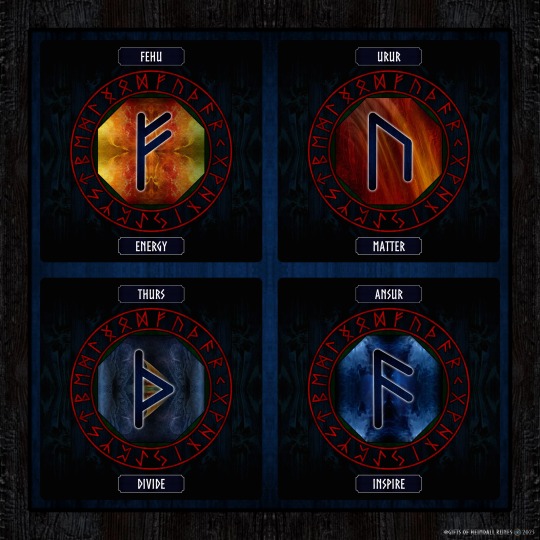
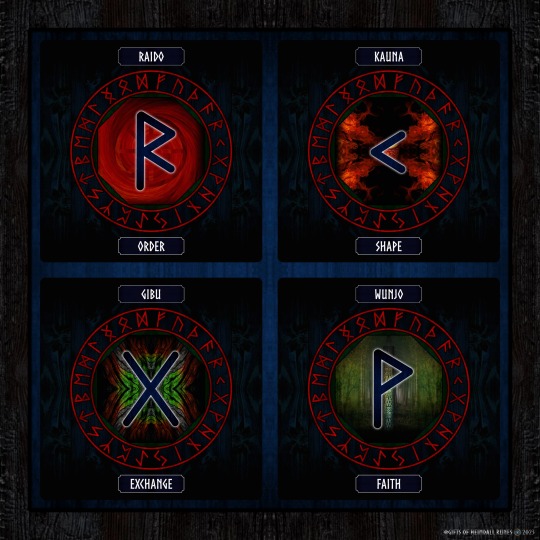
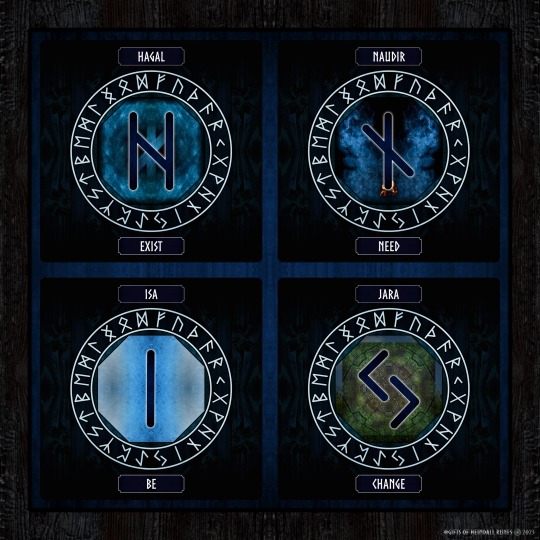
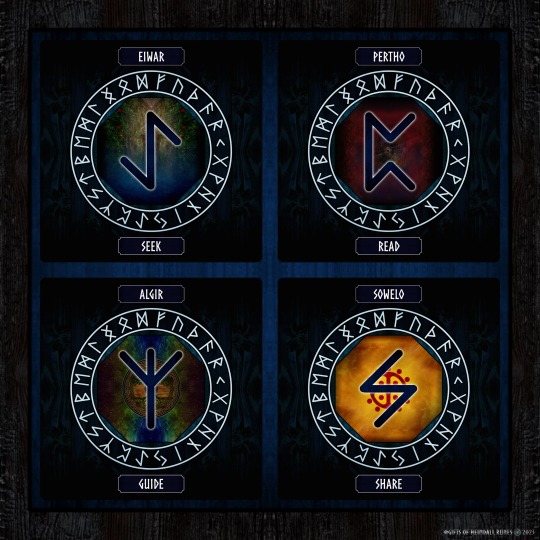

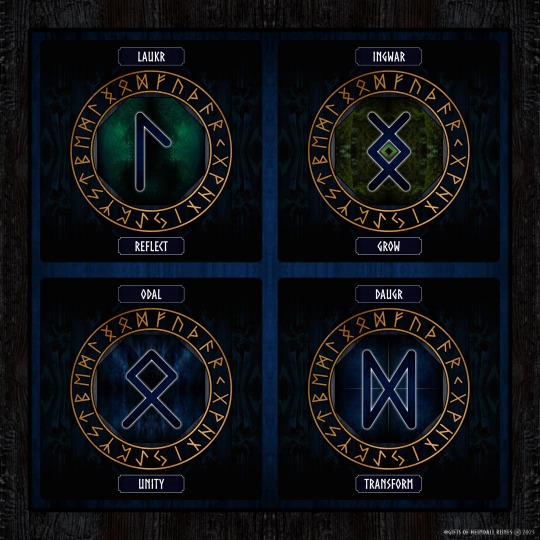
TEXTURES OF BIFRÖST - ABSTRACT STAVES
Elder Futhark Rune Art 2022
@Gifts of Heimdall Runes
●
"Textures of Bifröst - Abstract Staves" shared a rune art journey with twenty-four staves of the Elder Futhark. The project was an attempt to represent interactions with rune energy by creative expressions.
●
These designs were divided into three parts for this post:
○ Textures
○ Reflections
○ Rune Circles
●
The correspondences for runes were created as a gentle reminder of personal rune journeys over time. The text for each rune attempted to represent both a subjective journey within each individual rune and trans-personal initiations following the combined 24 staves of the Elder Futhark (beginning with Fehu & completing with Daugr.)
●
Rune names were taken from Wardruna albums 'gap var Ginnunga', 'yggdrasil' & 'Ragnarok'. The elective use of these rune names represented merely a personal tribute to Wardruna's wonderful music creations.
●
This project celebrated a continued journey with the runes and Spirit inspiration and to perhaps inspire others with their own rune travels. The project was created for fun and should only be considered as a product of a thoroughly eccentric middle-aged imagination that absolutely should know better but was now completely past caring!
●
'Textures of Bifröst' was created on & off within the first half of 2022, then shared October 2022 to March 2023 via social media platforms (Facebook, Instagram & partially Flickr.)
●
Reflections designs showed condensed ongoing personal rune meditations from 1997 to the present. Text showed some personal keywords and phrases formed by meditated interactions with each rune as well as engaging in study from various published authors. Content was also shared on 'Bifröst Shining' but again further developed for these designs.
●
The Brisingamen content with 'Reflections' came into consciousness with 'Bifröst Shining', which was shared 2021 & 2022. The myths and associations therein were still being worked upon. Future developments on this issue may, however, be forthcoming subject to Asgardian relations between Freya & Odhinn mitigated by intervention from Lokean mischief or Heimdallian diplomacy!
●
Collectively, each rune reflection card communicated an understanding of a journey of personal and trans-personal initiation throughout the three Ætts (eights) of the Elder Futhark that I have personally come to understand as:
●
○ First Eight: Journeys of Creation (as described by norse mythology).
○ Second Eight: Journeys Within: Norns and travelling Yggdrasil.
○ Third Eight: Journeys of Soul via the Norse Gods to Ragnarök.
●
Rune Circle cards showed condensed keywords from combined personal rune meditations. All rune correspondences in designs were subjective and should only be regarded as a load of nonsense that blossomed from an over-active aging hippy imagination.
●
Finally, the collection shown here was created for a private published copy by Make Playing Cards (MPC) that was adjusted to accommodate a 3.5 x 3.5 MPC template. The focus for 'Textures of Bifröst' from initial concept was on design, not publishing, which resulted in some slightly different pictures shared on Facebook & Instagram October 2022 to March 2023. Photos of these MPC printed rune art cards are also shown.
●
The project was dedicated to any steadfast followers that have kindly followed this journey with runes since 2019, and perhaps even before. Thank you, everyone!
●
'Textures of Bifröst - Abstract Staves' completed here.
The Gifts of Heimdall journey with runes continues.



Image Ref: World Tree Design
●
Gifts of Heimdall Runes (FACEBOOK)
Gifts of Heimdall Runes (INSTAGRAM)
#gifts of heimdall runes#gifts of heimdall#gifts of heimdall rune art#gifts of heimdall rune designs#HeimdallGiftsRunes#Rune#Runes#futhark#futhark runes#runes#norse runes#elder futhark#elder futhark runes#rune designs#rune art#elder futhark rune art#elder futhark rune designs#rune art cards#rune designs cards#personal rune art#personal rune designs#rune divination#rune magic#futhark rune art#futhark rune designs
34 notes
·
View notes